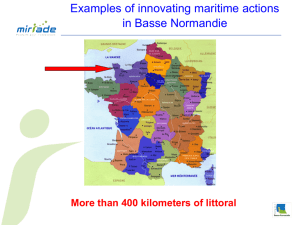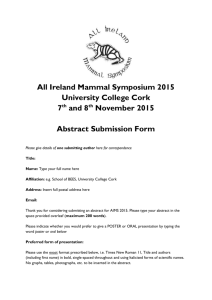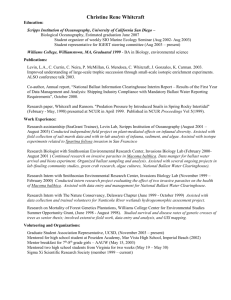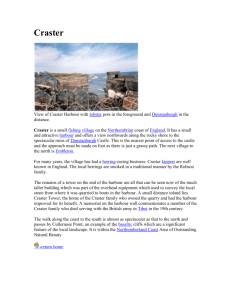'. ,
advertisement
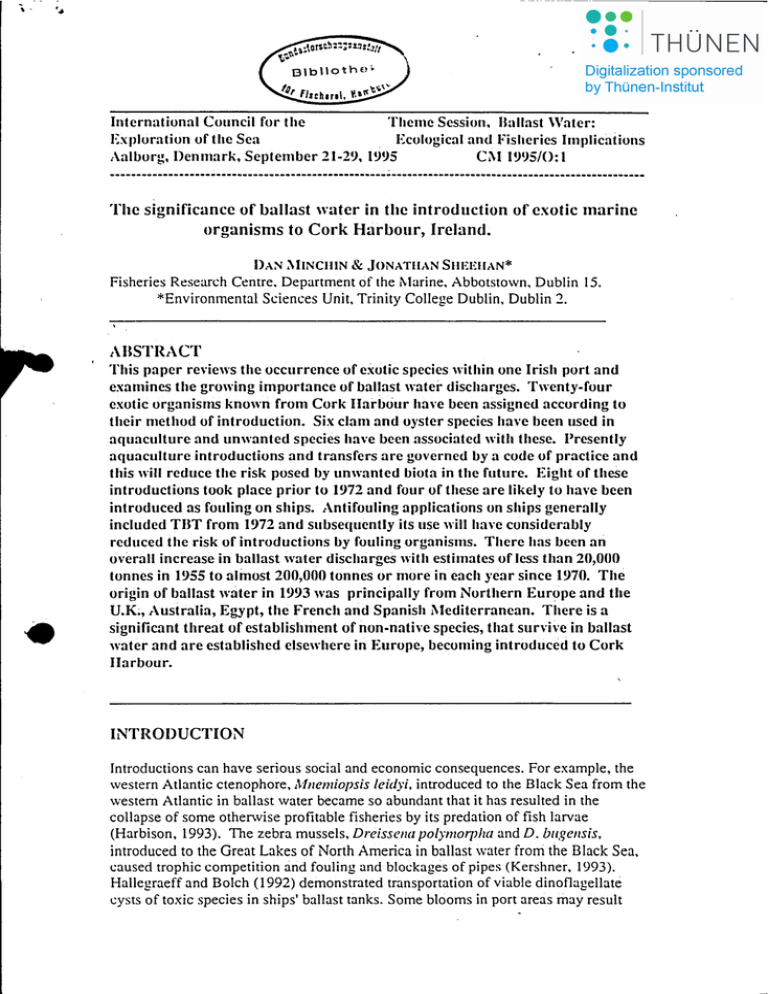
,.
'.
International Cmmcil for the
Theme Session. Ballast \Vater:
Exploration of the Sea
Ecological and Fisheries Implicaiions
Aalborg. Denmark. September 21-29. 1995
C~I 1995/0: 1
The significance ur ballast water in the introduction ur exutic marine
organisms to Cork Harbour, Ireland.
DA~ :\IINCIIIN
& JONATHAN SHEEHAN*
Fisheries Research Centre. Department of the i\larine. Abbotstown. Dublin 15.
*Environmental Sciences Unit. Trinity College Dublin, Dublin 2.
ABSTRACT
•
This paper reviews the occurrence of exotic species within one Irish port and
examines the growing importance of ballast water discharges. Twenty-four
exotic organisms known from Cork I1arbour have been assigned according to
their method of introduction. Six c1am and oyster species have been used in
aquaculture and unwanted species have been associated with these. Presently
aquaculture introductions and transfers are governed bya code of practice and
this will reduce the risk posed by unwanted biota in the future. Eight of these
introductions took place prior to 1972 and four of these are Iikely to have been
introduced as fOltling on ships. Antifouling applications on ships generally
included TUT from 1972 and subsequently its use will have considerably
redllced the risk of introductions by fouling organisms. There has been an
overall increase in ballast water discharges with estimates of less than 20,000
tonnes in 1955 to almost 200,000 tonnes or more in each year since 1970. The
origin of ballast water in 1993 was principally from Northern Europe and the
U.K;, Australia, Egypt, the French and Spanish Mediterranean. There is a
significant threat of establishment of non-native species, that survive in ballast
water and are established elsewhere in Europe, becoming introdllced to Cork
I1arbour.
INTRODUCTION
Introductions can have serious social and economic consequences. For example. the
western Atlantie ctenophore. Mnemiopsis leidyi. introduced to the Black Sea from the
western Atlantie in ballast water became so abundant that it has resulted in the
collapse of some otherwise profitable fisheries by its predation of fish larvae
(Harbison, 1993). The zebra musseis, Dreissenll polymorplza and D. bltgensis.
introduced to the Great Lakes of North America in ballast \Vater from the Black Sea,
caused trophie competition rind fouling and blockages of pipes (Kershner, 1993).
Hallegraeff and Bolch (1992) demonstrated transportation of viable dinoflagellate
cysts of toxie species in ships' ballast tanks. Same blooms in port areas may result
from eyst inoeulations from ballast diseharges amt may spread to compromise inshore
fisheries and aquaculture activities.
Over the 20th century marine transportation has expanded rapidly, with shorter transit
times between ports. The risk of unintended introductions has increased with faster
trave!. Boudouresque (1994) has indicated that most exotic species in southern
Europe have become established since the 1950s, with the principal sites of
establishment being in lagoons (23 to 24 spedes) and ports (13 to 14 species).
Some spedes considered to be exotics may be previously unknown natives or have
arrived as part of a natural range expansion. Others have been deliberately introduced
for aquaculture and in certain eases have been the vectors of unwanted species. A
third group are those species introduced by shipping. The increasing use of water as
ships' ballast is thought to be the most important vector 01' exotic organisms in the
future.
Cork Harbour, a large natural sheltered bay on the south coast of Ireland, has some
features not unlike a coastallagoon and is also an important port. This area contains
a significant number of exotie species. This paper examines the historieal
infonnation on aquaculture, shipping movements, estimates of ballast water and the
literature on the exotic species to ascribe the likely means by which these exotics
arrived. This paper explains why ballast water poses the most significant means far
the introduction of exotie species in the future.
MATERIALS AND METIIODS
Cork Harbour is a large natural sheltered bay and the principal port on the south lrish
coast (Fig. 1). It has a cool temperate climate with sea temperatures ranging from 519°C and with estuarine to coastal marine conditions. The Harbour is regularly
dredged to provide ship access to Cork city. There are deepwater berths at Cobh and
at industrial centres. Oyster culture has also been developed (Fig. 1).
The occurence of exotic species in the harbour was sourced from the literature and
unpublished observations. The accumulated net registered tonnage (NRT - a
volumetrie measurement calculated from the capacity in cubic feet of spaces within
the hull, and of enclosed spaces above the deck available for cargo stores and fuel,
divided by 100 (Anon, 1991)) and number of vessels were obtained for the period
1928-1993. The NRT does not provide a direet measurement and does not relate to
weight of exports because it is a capacity measurement. Dead or gross weight
tonnage (DWT) was not recorded because this was not available for the period 19281993. A regression of changes in NRT and exports since 1955 gave a high
correlation of 0.916 (using ~tINITAB), demonstrating that a reasonable estimate of
exports over that period could be calculated based on NRT values.
By using back extrapolations of numbers of vessels both import/exporting or just
importing, the proportion of vessels exporting could be calculated, based on the
records of shipping activities for 1993. It has been assumed that the relative
proportions in 1993 were the same to 1955 and that all exporting vessels were of the
same size. The tonnage exported was calculated as folIows:
Total pure exports
= (Total exports/Total /Illmber ofexportillg ressds) x Total
I/umber ofpure exportillg ressels.
Pure exports refer to those products which were exported from Cork Harbour in ships
that arrived carrying ballast water. To cakulate annual ballast water discharge
volume a conversion factor from NRT to dead weight tonnage of approximately 2.0
was obtained from a random selection of ships from the maritime directory. This
figure was then was multiplied by 0.35 to obtain the total ballast capacity (mean value
of 0.32 to 0.38 for various vessels including tankers) and then by 0.24 to calculate
ballast water on arrival ( a mean value based on volumes carried in tankers 0.13. and
container vessels 0.35) (Carlton et al.• 1995). Estimates of ballast discharges may be
compromised because vessel ballast volumes depend on ship design. weather
conditions and planned cruise track. The origin of ships arriving with ballast to Cork
Harbour were examined for 1993. In this exercise the estimates of ballast water
discharges from all sources have been combined.
RESULTS
Exotic species were classified as either deliberate or unintended introductions (Table
la & Ib) Some species are known to have been present over a short time and may
not have become established. The distribution of those species considered to have
become established are recorded for three regions of Cork Harbour(Fig. 2).
Intended introductions
With the exception of the ricegrass. Spartina x towllsendii, introduced from Poole in
Britain to stabilise mud flats near Lough Mahon in 1925 (Curnmins, 1930), all
intentional introductions were for aquaculture.
Oyster cultivation began following a decline of production on public beds, from 1860
in Lough Mahon (47 hectares), the Middleton River (10 hectares), Owenboy Estuary
(31 hectares) and elsewhere in the Harbour from 1873 (48 hectares) (Wilkins, 1989).
Beds were restocked using half grown flat oysters. Ostrea edulis regularly imported
from France. From 1882 half-grown American oysters. Crassostrea virgillica. were
introduced, approximately 600.000 were laid on the Middleton bed in 1895. Halfgrown Portugese oysters, Crassostrea allgulata. were laid from 1892 to 1898,5,000
at Lough 1\1ahon, and later >8,000 within the Owenboy Estuary. The extent of the
oyster fisheries at the turn of the century was recorded by Brown (1900) who refers to
young native oysters, O. edulis. [rom the natural settlement area of Arcachon being
relaid at the Middleton and Owenboy layings (Fig. I). \Vith up to 300,000
transferred in any one year from elsewhere in France and from the Netherlands,
American oysters continued to be imported until the 1920s but overall numbers
imported are unknown. Oyster culture in the harbour then declined and ceased
although licensed areas were in existance.
Oyster cultivation did not again take place until 1969 when O. edlilis settled as spat in
ponds beside the North Channel, were laid on the seabed, or ongrown in bags on
trestles. The broodstock was sourced from public oyster fisheries in Ireland,
principally Tralee Bay. Pacific oysters, Crassostrea gigas, previously quarantined in
Conwy, were cultured on trestles in the same area from 1976, and their production
3
rapidly expanded and new oyster growing areas evolved. Because this species rarely
spawns in Irish waters. spat for culture are produced in hatcheries and most are
imported from Britain and Guernsey. In IYY3. as a result of EU legislation to
promote free trade (Anon.. 1YY 1). half grown Pacific oysters \vere transferred to
Ireland from France.
Other exotic molluscs were used in aquaculture trials: the hard shell c1am.
Mercel/aria mercellaria, not currently in culture. and the Pacific c1am. Tapes
phi/ippil/arum, are cultivated in small quantities. Both were quarantined in Conwy.
The soft shell c1am. Mya arellaria. has been established in same European ports for
some centuries. and is established in Cork Harbour. It is not c1ear whether this
species was intended as food when introduced to Europe..
Unintended introductions
•
/Iltrodllced species associated with aqllacllltllre
Uncontrolled movements 01' molluscs may result in the establishment of undesirable
species. for example the sporozoan BOl/amia ostreae. which infects the blood of O.
edlllis, may have been introduced with contaminated oysters in 1986 (McArdle ef al.,
1991). In 1980. an eroded gill condition was found in up to 6% of O. edlllis in the
North Channel. similar to that produced by an elusive poecilostome copepod.
Herrmal/nella clllggalli. (Holmes & Minehin. 1991) known from Ireland and Brittany.
Its status as an exotic species is not certain but may have become established in
Ireland following earlier oyster transfers from continental Europe.
A consignment of half-grown Pacific oysters from France in 1993 were laid in the
harbour and were removed same weeks later. They contained two copepods, Myicola
ostreae, attached to gills. and Mytilieola orientalis, a gut parasite of molluscs. These
species are not known to have become established in Cork Harbour.
/Iltrodllced species associated witTz slzippillg
It is not clear whether many of the exotic marine algae. such as BOllnemaisollia
Izainijera found at Camden (Cullinane. 1973) were introduced by shipping but they
may have been transported as attached plants on ships' hulls. The first lrish
specimens of B. Izamijera were washed ashore in Achill Sound in 1911 (in the
National Herbarium, Dublin. DBN) and so the species is likely to have been present
before this date elsewhere, at a time when little or no ballast water was used by ships
for stability. Similarly Codillmfragile tomentosoicles, found at Corkbeg by Cullinane
(1973). has been known from Ireland since 1833 (DBN). A further species.
Colpomellia peregrina, had become established in France by 1905 and was first found
in Lough Hyne, Ireland in 1939. This species may have reached Ireland as drift
because it has a light thallus which when filled with air or gasses can float proud of
the water and so become easily dispersed by wind. It mayaiso have been transported
in weIl boats involved with exports of lobsters from the lrish south coast. In 1971 a
foliose red alga. CI)1Jtonemia Izibernica. was described for the first time from Cork
Harbour (Guiry ef al., 1973); it has since been recorded from nearby Oysterhaven
(Cullinane & Whelan. 1980). It is not known elsewhere in Europe. but its abundance
and highly localised distribution and affinities with Pacific species strongly suggest
that it is an introduction.
4
The New Zealand barnacle. ElmillillS 1JlOdestllS. and the Koreansea-squirt. Styela
dava. were probably introduced as fouling. E. modestIls is the most frequent
barnacle in Lough ~lahon und North Channel and is common at the Harbour entrance.
The first Irish record was from Lough Hyne (Beard. 1957); it was probably
established in Cork Harbour before then. and was first seen in the Owenboy Estuary
in 1968. Crisp (1958) records its expansion on the south coast of Britain from 1946
(Fig. 4). where it is thought to have been established since 1939.
Styela c1ava became established on the south coast of Britain and is thought to have
been introduced by returning warships following the Korean \Var. It was already
established in Cork Harbour in 1972 (Kilty & Guiry. 1972). In 1987 it was widely
distributed within the upper Harbour and \'las also found to be common on the hull of
a moored 'lessel (~linchin & Duggan. 1988).
Mytilicola iJltestillalis, a gut parasite of musseis. was first found in Ireland in 1947
from Fountainstown and Church Bay in Cork Harbour (Grainger. 1951); it is now
weIl established. It is likely that it was introduced from larval releases from its host
MytilliS edlilis, a known fouling organism of ships. The first record outside of the
~lediterranean was from the North Sea (Caspers. 1939). More recently its status as
an exotic species has been questioned. but it sporadic occurence. principally within
Irish bays with ports and earlier absences. provide evidence that it is an introduction
dose to its northern range (Grainger. pers. comm.).
The serpulid Ficopomatlls clligmaticlls, which may form extensive intenwining
masses in estuarine areas, is considered to have been introdueed to Europe from the
Indo-Pacific (Fauchild. 1977) as ships' fouling during the first world \Var (Zibrowius,
1994). It was first recorded from Cork Harbour by Kilty & Guiry (1973) near Cork
city, further specimens were seen in Lough Mahon in 1986 and 1993. This species
may have been introduced directly from Swansea where there is a loea1 population
(Kilty & Guiry, 1973) by the regular ferry service between Cork and Swansea.
The species Gyrodillillm allreoillm deseribed from the western North Atlantie by
Hulbert was first recorded in the eastem Atlantic by Braarud and Heimdal (1966) on
the S\V coast of Norway and may have been introdueed to Europe as ballast water.
Since then it has been observed at a number of other loealities and probably arrived
by spreading at coastal fronts. There is, however. some taxonomie eonfusion with a
form from the Pacifie. Its initial appearanee in Europe may have been due to ballast
water. It was first notieed on the south Irish eoast in 1976. when it formed blooms.
Although it has appeared in water sampies since 1981 in Cork Harbour. it is not
known to have bloomed there.
Alexandrillm tamarense forms blooms in eoastal areas and may eause paralytic
shellfish poisoning. A bloom, of low toxicity, of this species was first recorded in
Cork Harbour in the spring of 1985 in the Nonh Channel, Owenboy Estuary and near
Spike Island. No eysts of this genus \Vere found in a 1993 study. It is not clear
whether this species is native to Cork Harbour or was transferred or introduced in
ballast water at some former time.
5
Qllalltijyillg the relath'e risk from shippillg
Estimated annual discharges of ballast water into Cork Harbour rose from 1955 to
1971. during the 1970's much of the ballast water entering the harbour will have been
as a result of the extensive dredging taking pläce as a result of harbour developments
over that time: these vessels will have taken on ballast on return to the harbour
following disposal of spoil at the nearby dumping ground. The ballast discharges
again rose consistantly from 1982 (Fig. 4). Increases of ballast discharge retate to
periods in the development of and export of spedalised products such as oil. steel.
chemieals and livestock (Table 2). In 1993 the majority of vessels carrying ballast
were assodated with oil products and consequently the opening of the Whitegate oil
terminal in 1959 is a significant factor in the volumes of ballast discharged.
•
Patterns of shipping entering the port of Cork show an obvious decline in the gross
tonnage of liners to 1972 (Fig. 3). Liners. which are unlikely to hold significant
quantities of ballast. when entering Cork Harbour were principally in transit to and
from North America. but when disembarkation took place liners either anchored
south of the Harbour entrance or when conditions were suitable smaller liners
anchored off Spike Island or berthed at Cobh for short periods of time. The large
volume of liners until the 1960s may have been significant for innoculations of
fouling organisms to have taken place. Although the shorter time spent by liners may
have meant that the risks were reduced. Nevertheless, changes in temperature and
salinity on entering the harbour may have promoted spawnings which could have led
to recruitment. The greatest changes in temperature and salinity would have been at
the berths in Cork city where in the earlier years, and before the development of the
Tivoli and Ringaskiddy dock sites were developed, most of the non passenger
shipping traffie would have gone.
The net rate tonnage (NRn of merchant vessels trading with the U.K. has been
500.000 tonnes or less from 1928, declining during the Second \Vorid War.
Following the war tonnage increased to 2,500.000 tonnes in 1974 and then generally
declined. There has been a continual trend of increased NRT with continental Europe
and elsewhere to 4.000,000+ tonnes in 1992. With the increase in NRT, from a wider
range of ports, the potential of an exotic innoculation has increased. Pre and post war
port facilities were not as efficient as in present times and the turnaround time of
trading vessels, then principally centred at Cork city, was some days. The efficient
biocidal antifoulant TBT paints, widely available to shipping since 1972, may have
significantly reduced the potential for dispersal of fouling organisms, by reduction of
fouling biomass. Although the International Maritime Organisation have
recommended further controls on its general use by shipping, whatever replaces it
will need to be as effective.
In Ireland there are presently no general controls on segregated ballast water or
procedures for managing discharges with the exception of controls on oily ballast.
Ballast ,"vater was first regularly used in the 1880's (Carlton & GeIler, 1993). This was
a more economic method of ballasting as it was rapidly done and required less Iabour
than stone ballast. The sites where deballasting takes place and the volume
discharged depends on ship design, sea state and the nature of the cargo. Vessels
normally discharge at the first available opportunity so as to reduce time spent in port.
Oil tankers. in particular, can discharge ballast near their destination while under way
and most usually before berthing, because oil products are rapidly loaded, providing
6
- - - - -
~--
--~
---
insufficient time to enable deballasting, while berthed in port. On older ships ballast
water would be taken on in empty oil tanks. However, there are fadlities at
Whitegate to pump dirty ballast water to tanks ashore, where oil can be removed
before the water is discharged. The greater proportion 01' tfading vessels in Cork
Harbour are associated with oil products and since the terminal is near the Harbour
entrance some deballasting may commence while at sea and so may reduce the
efficacy of a potential innoculum.
Since the 19705. the usage of TBT antifouling paints, has had a major impact on
transfers of fouling organisms on ships. This bioeide may modify the viability of
innocula from ships' ballast water. Discharges 01' fine sediment from ballast tanks
may become deposited along with fine sediments known to aet as a sink for TBT in
port areas. Polychaetes and other soft sediment fauna and possibly some algal cysts,
settling in these areas, may consequently become constrained from establishment. It
mayaiso influence previously established populations.
The last port of call (LPC, being the port at which the ballast water was loaded), by
region, of vessels visiting Cork Harbour in 1993 containing ballast water is shown in
Table 3. The risk of introductions may be greater where there is much traffie
throughout the year from the same LPC, partieularly for those species whieh have
seasonal eycles of abundance. Future introduetions to Cork Harbour, will as a
eonsequenee, be likely to evolve following their establishment in northern European
port areas, for example Glasgow, Liverpool, ports along the Bristol Channel and
Rotterdam. It should be noted that the LPC does not always provide an aecurate
aeeount of the ballast water transported, beeause deballasting and ballasting may take
plaee while in transit or may have been eontained from earlier visits. Sediments will
aeeumulate from several ports in ballast tanks.
In 1993, vessels arrived from elsewhere in Ireland and Britain, continental Europe,
north Afriea, the ~fiddle East and Australia. It is clear from Table 3 that vessels
distributing oil produets diseharge the largest volume of ballast water into the
Harbour. This is followed by ships exporting ehemicals and steel. Almost all the
.vessels arriving in ballast, that load ammonia, are from Belfast. This route eould
result in the introduction of species to Cork Harbour previously introdueed to Belfast
Lough. Forty-two ships arrived carrying ballast water from north Afriean ports (33
from Alexandria and 7 from Tripoli) to export livestoek. This route may permit
aeeess of Mediterranean biota to Cork Harbour.
DISCUSSION
High exploitation of oysters during the mid-nineteenth century resulted from a rapid
and reliable steam transportation by rail and sea, and improved marketing. Depletion
of oysters lead to several introductions to Ireland of half-grown O. edllfis, often in
large numbers, from France, Britain and the Netherlands into the 1950s in order to
enhanee stocks and maintain oyster production. There \vere also extensive and
sustained introductions of American oysters to Ireland and Britain during 1880-1920,
from Long Island Sound, which \vere laid in several areas including Cork Harbour.
Importations from the same source resulted in the establishment of slipper limpets,
Crepidula[omicata and the American tingles Urosalphinx cillerea to the south-east
7
coast of Britain (Utting & Spencer. 1992). C. fornicata spread throughout much of
northern continental Europe in the following hundred years. principally with oyster
transfers. As its range expanded within Europe the risk of it becoming introduced
with relayed oysters from the continent increased (i\linchin. et al.. 1995).
Several organisms have been moved unintentionally with introductions and transfers
01' oysters. These risks are greatest with movements 01' half-grown oysters. Parasites
and diseases. intimately associated with molluscs. are likely to be transferred. Three
(B. ostre(1e. M. il/t('stil/aUs ami H. duggal/i) are thought to be established in Cork
Harbour.
It is likely that associated biota arrived in Cork Harbour with the large volumes of
American oysters introduced and may indude species that have now become
established within natural communities. possibly including planktonic species. Asian
coastaI copepods have appeared in California. USA and in Chile. all in areas 01'
Pacific oyster cultivation (Omori et al.• 1994). The implication is that Pacific oyster
cultivation has resulted in the introduction of Asian coastal copepods to these areas.
Such planktonic species may survive being transferred in the liquor within the mantle
cavity. as is known for Myicola ostreae.
Prior to 1993, shellfish and fish importations to Ireland were refused from
unrecognised or uncleared areas. because being an island there was same freedom
from pests. parasites and diseases. However. under EU Directive 91/67/EEC
designed to improve trade within Europe, free movement of Pacific oysters not
subjected to listed diseases. in Europe was allowed. The subsequent imponations
resulted in additional species being introduced to Ireland (Minehin et al.. 1993),
including a short appearance of M. ostreae and M. orielltalis not previous1y known to
have appeared in Cork Harbour.
It has been an aim of the International Council for the Exploration of the Sea to
reduce risks associated with aquaculture introductions and with trade, and a code of
practice has recently been updated (Anon, 1995) to take account of such shellfish
movements, and to address the planned development of new species for aquaculture
within ICES member countries. This code covers not on1y the consequences of the
introduced species but outlines measures for prevention of release of associated
species. by recommended procedures in quarantine. Intended molluscan
introductions themselves seldom result in negative effects and correct implementation
of the ICES code considerably reduces the risk of unwanted effects.
Tenacious species and associated biom may become widely distributed on ships hulls.
The ascidian S. clava. a frequent fouling organism in the north-west Pacific. has
spread within northern Europe since 1952. It had become established in Cork
Harbour by 1972 and can only have colonised Cork Harbour between these dates
(Fig. 3). Simi1arly, E. modestlls, introduced during the second world war to Britain
from New Zealand. rapidly expanded its range in Europe and had become established
in Cork Harbour before 1968, when it was first recorded (Fig. 3). The serpulid F.
clligmatica may have been introduced to Ireland between the end of the First World
War to 1972. Although trade with Britain was relutively low prior to the Second
World War, there may have been a better opportunity for its establishment due to the
slower turnabout times in port. The introduction of M. imcstillalis dearly occured
before 1947. and as the shipping traffk at this time was very low. due to the Second
World War. it is likely that it became established prior to 1941.
The estimated volumes of ships' ballast discharges into Cork Harbour will merely
renect a general trend. which demonstrates that there is indeed an increase in annual
ballast water discharges from a low level in 1955. The estimates have not induded
ballast discharges from vessels other than those with a net export from the harbour.
~lany other ships will have discharged ballast water and consequently the tigures are
under-represtented. In addition the ballast discharges of tankers following the
opening 01' the Whitegate Refinary are likely to provide lower figure than shown in
Figure 4 if these were known. this is because. the ballast water on arrival will be less
than the ballast capacity of the ship, and this can vary widely from 0.13 of the gross
tonnage of tankers and is lower than the mean value 01' 0.24 used in all annual
calculations. Since the expansion 01' the port facilities (Table 2) the container vessel
traffie has inereased and the ballast water on arrival of such vessels approximates to
0.35.
Cork Harbour has acquired marine biota from aquaculture, ships' fouling and possibly
ships' ballast. The ICES Code of practice first adopted in the 1970's has resulted in
much tighter controls on species introductions associated with aquaculture, and so the
risks of undesirable species' introductions are considerably reduced.. The use of TBT
antifouling paints on ships' hulls since the 1970s is also likely to significantly reduce
the risk of introductions via ships' fouling. Ballast water, however, has increased in
importance since the 1960's and may act as the main source of future introductions.
The question of the control of ballast is under discussion by ICES and the
International Maritime Organisation (lMO) with a view to finding adaquate control
methods, using either continuous exchange of ballast at sea, biocidal methods or
contained ballast transfers.
In this exercise it has not been possible to quantify accurately the volumes of ballast
discharged and the development of a register of source, volumes, times and dates of
taking on ballast by compartment by port authories would greatly aid management.
Technological developments and data bases of nuisance species distributions and
algal bloom events may aid in the treatment of ballast once effective and practical
methods of controlling nuisance species in ballast have been developed.
ACKNO\VLEDGEl\IENTS
We would like to thank Mark Holmes of the National Museum of Ireland, Colm B.
Duggan of the Fisheries Research Centre and Seamus McLoughlan, the Marine
Surveyor, for information provided. Dr Donal Synott permitted me to examine
material in the National herbarium. Statistical returns were supplied by the Cork
Harbour Commissioners on the net tonnage of vessels entering the port and Capt
Patrick Farnan kindly commented on the draft and Capt. Jerry Desmond assisted \Vith
ballast conversions.
l)
REFERENCES
..\non.. 199 I. Register o/ships IlJlJ1-1992. Lloyds register 01' shipping. London.
Anon.. 1994. 1994 Code 01' Practice on the Introductions and Transfers 01' marine Organisms.
ICES Cr-.l1994/ENV:1I. 12pp
Beard. D.M.. 1957. Occurrence 01' Elminius modestIls Dmwin in Ireland. Nature. 180: 1145.
Boudouresque. C.F.. 1994. Le especes introduites dans I'eau cutieres d'Europe et de Mediterranee:
Etat de la question et consequences. In: Boudouresque. C.F.. Briand. F. & Nolan. C.(eds).
If1troduced species in European coastal Wafers. Ecosystems Research Report. 8. European
Commission. BrusseIs. pp44-49.
Bra...1.rUd. T.. & HeimdaI. B.R. 1970. Brown water on the Norwegian coast in autumn 1966. Nytt Mag.
Bet.. 17: 91-97.
•
Brown. T.1.• 1903. Report on the shellfish layings on the lrish eoast. Stationary Office. Dublin.
148pp.
CarIton. J.T.• Reid. D.M. & van Leeuwen. H.• 1995. The role 0/ shipping in the introduction o/nonindigenous aquatic organisms to the coastal waters 0/ the United States (other thanthe
Great lakes) and an analysis 0/ eOlllrol options. The National Biological Invasions Shipping
Study (NABISS). United States Coast Guard and the National Sea Grant Program. 213pp.
CarIton. J.T. & Geller. J.B .• 1993. Ecological roulette: the global transport of nonindigenous marine
organisms. Science, 261: 78-82
Caspers. H. 1939. Über vorkommen und metamorphose von Mytilicola illlestinalis Steuer
(Copepoda) in der sudlichen Nordsee. Zoologischer Anzeiger 126: 161-171.
Cullinane. J.p.. 1973. Phycology o/the South Coast o/Ireland. Cork University Press. Cork.
Cullinane. J.P. & Whelan. P.M.• 1980. Ecology. distribution and seasonality of Cryptonemia
hibernica Guiry et Irvine on the south coast of Ireland. In: Proceedings o/the 10th
Seaweed Symposium, Goteborg. Sweden. August 11-15 1980 (Ler....ing. T. ed.): 259-264.
•
Cummins. RA .• 1930. Experiments on the establishment of the rice grass (Sparrina Townsendii) in
the Estuary of the Lee. Economic Proceedings o/che Royal Dublin Societ)', 2: 419-421.
Crisp. D.1.• 1958. The spread of Elminius modestus Darwin in north-west Europe. J. mar. biol. Ass.
U.K., 37: 483-520.
Fauchild. K.• 1977. The polychaete ",orms. definitions and keys 10 the orders,jamilies and genera.
Natural History Museum. Los Angeles. Science Series 28.
Grainger. J.N.R.• 1951. Notes on the biology of the copepod Mytilieola illlestinalis Steuer.
Parasitology, 41: 135-142.
Gruet. Y.• Heral. 1\1. & Robert J-M .• 1976. Premieres observations sur l'introduction de Ia faune
associee au naissan d'huitres Japonaises Crassostrea gigas (Thunberg). importe sur la eute
Atlantique Franc;:aise. Cahiers de Biologie Marine, 17: 173-184.
Guiry. G.l\t & Guiry.l\1.D.. 1973. Spread of an introduced ascidian to Ireland. Marine Pollution
Bulletin. 4: 127.
10
--------------------------1
Guiry. 1\1.D.• Irvin~. L.1\t.. & Famham. W.F.. [973. A sp~ci~s 01' Cryptonemia new to
P/lyrvl. J. 9: 225-237.
Europ~.
Br.
Hall~graeff. G.1\1.
& Bolch. C.J.. 1992. Tr;msport 01' diatom ~md dinol1agellate resting spores in ships
water: implications for plankton hiogeography ~md aquacuhure. Jvurnal v/Plankton
Research 14 (R): 1067- IOR4.
ha[[~l"'t
Harbison. R.. 1993. The invasion of the Black Sea and the mediterranean by the American comb
jelly Mnemivpsis. Workshop onllonindigenous ESlllarine and marine Organisms. Seattle.
Washington. 20-22 April 1993 (Ahstract).
Holmes. J.M.C. & Minchin. D. 1991. A new species 01' llerrmall1zella (Copepoda. Poecilostomatoida.
Sabelliphilidae) associated with the oyster Ostrea edulis L. Crustaeeana 60: 258-269.
Kershner. K.. 1993. Showing our musseI: the Great Lakes Sea Grant Network Report on Zebra
mussel research and outreach. Ohio State University. Ohio. 72pp.
Kilty.G.M .. & Guiry. M.D.. 1973. Afereierella enigmatica Fauvel (Polychaeta. Serpulidae) from
Cork Harbour.lrish Naturalists' Journal. 17: 379-381.
McArdle. J.F.• McKieman. F.. Foley. H. & Hugh Jones. D. 1991. The current status of Bonamia
disease in Ireland. Aquaeulture. 93: 273-278.
Minchin. D. & Duggan. C.B .• 1988. The distribution of the exotic ascidian. Styela clava Herdman. in
Cork Harbour. Irish Naturalists' Journal, 22(9): 388-393.
Minchin. D.• Duggan. C.B.• Holmes. J.M.C. & Neiland. S.• 1993. Introductions of eXOlie species
assoeiated with Pacifie oyster transfers 1'rom Franee to Ireland.ICES C.M. 1993/F:27. Ilpp.
Minchin. D. McGrath. D. & Duggan C.B.• 1995. The slipper limpet. Crepidula fornieata (L.). in Irish
\Vaters. with a review of its occurrence in the north-eastern Atlantie. J. COlleh .• 35: 247-254.
Omori.I\1.. Van der SpoeI. S.• Norman. C.P.• 1994. Impact of human activities on pelagic
biogeography. Prog. Oeeallog. 34: 211-219.
Utting. S. & Spencer. B.• 1992. Introductions of marine bivalve molluscs into the United kingdom
for commercial culture. case histories.ICES mar. Sei. Symp. 194: 84-91.
Wilkins. N.P.• 1989. Ponds, passes and pares: aquaeulture in Vietorian Ireland. Glendale Press.
Dublin. 352pp.
Zibrowius. H.• 1994. Introduced invertebrates: examples of success and nuisance in the European
Atlantie and in the Mediterranean. In: Boudouresque. C.F.. Briand. F. & Nolan. C.(eds).
Introdueed speeies in European eoastal waters. Ecosystems Research Report. 8. European
Commission. Brussels. pp44-49.
11
Table la. Spel:ies introdul:ed intentionally to Cork Harbour. * M. arenaria may have
been introduced as ships fouling.
SPECIES
Spartina x
lOwllsenJii
Mya arenaria *
Crassostrea
drginica
A8UNDANCE
Abundant
VECTOR
Ship transfer
Generally
distibuted
Abundant in years
1880-1920.
Unknown
Crassostrea
<Jngu/aw
18lJOs
Crassostrea gigas
Abundant
Jlercefzaria
mercenaria
rare or no longer
present.
Tapes
phi//ippinarum
Frequent
Aqual:ulture
Aquaculture
Aquaculture.
introduced in
1970's
Aquaculture mals
in 1960's and
1980's
Aquaculture.
inlfoduced in
1980's
COMMENT
Arrived in Cork
Harbour 1925
Widely distribuled
about Ireland
Never became
established. Relaid
and sold
Never became
established.
Relaid and sold
Part of current
large scale
aquaculture
Not established
Small scale
aquaculture
activities
Table Ib. Species unintentionally inlfoduced to Cork Harbour. MOsllikely vel:tors
of inlfoduction to Cork Harbour are shown in bold pnnt.
SPECIES
ABUNDANCE
VECTOR
COMMENT
BOfzamia ostreae
GyroJinium
aureo/um
Cryptonemia
hibemica
Frequent
Established
Common
Established
Abundant
Established
Oyster transfers
Ship transfer
Range extention
Unknown
Ships fouling
Ships ballast
[dentified 19X7. oyster
disease organism
Forms algal blooms
Bonnemaisonia
hamifera
Co/pomenia
peregrina
Present
Established
Frequent
Established
6
C/adophora
sericea
May be
common
7
Codiumjragi/e
subsp.
Occasional
Established
Ships fouling
Unknown
Drift
Oyster transfers
Ships fouling
Ships fouling
Ballast water
Oyster transfers
Unknown
S
tomentosoiJes
Ficopomatus
enigmaticus
Occasional
Established
Ships fouting
9
E/minius modestus
Abundant
Established
Ships fouling
10
Myti/ico/a
intestinalis
Myti/icola
orienwlis
Jlerrmanne//a
duggani
Frequent
Established
Rare
Ships fouling
in musseis
Oyster transfers
Ol:casional
Native species'!
Oyster transfers
2
3
...
5
11
12
13
Myicola ostreae
Rare
Oyster transfers
14
Corophium
sextonae
Stye/a c/ava
May be
common
Frequent
Established
Ships fouling
15
Shlps fouling
New spel:ies. now spread
to Oysterhaven. first
record 1971
Cullinane. 1913 generaJly
distributed
Cullinane. 1973 generally
distributed
CuJlinane. 1973
Parkes. 1975 generally
distributed
[n Ire[and only known in
Cork Harbour. First record
1972
Causes extensive fouling
in brackish areas. ftrst
record 1972
Gut parasite in musseis.
recorded sinl:e 1947
Briefly introduced on
oysters in 1993
New species. causes giB
damage to oysters. 198
Briel1y introduced on
oysters in 1993
First recorded by Costello
in 19
First recorded In 1972.
Tab1e 2. Deve10pment of Port of Cork facilities
Year
Port Area
Product
Development
1946
1959
1960
1969
1970
1970
1972
1979
Haulbowline
Whitegate
Haulbowline
Tivoli
Tivoli
Ringaskiddy
Haulbowline
Marino Point
19RI
Ringaskiddy
Steel first made
Gil refinary opens
Steel plant modemised
Car ferry terminal opens
Livestock terminal opens
Container terminal opens
Modemisation of steel plant
First production of natural
gas products
Berthing facilities open
1982
19R6
Ringaskiddy
Ringaskiddy
Steel
GiI, oil products
Steel
Cars. passengers
Livestock
Containers
Steel
Ammonia, urea,
fertilisers
Timber. wood
products
Cars. passengers
Containers
Car ferry terminal opens
Deepwater berthing temlinal
opens
Table 3. Origin, by area of ships carrying ballast water to Cork Harbour far 1993.
Commodity
Ire land (+
N.lreland)
Oil
Chemicals
Steel
Wood
Livestock
Foodstuffs
Total
181
95
62
41
0
9
388
Origin of ships carrying ballast water
Northern Eastern
Western
Southern
Europe
Medi·
Medi·
Medi·
terranean terranean terranean
12
0
0
0
92
1
3
0
0
53
9
0
0
0
22
2
0
0
0
35
42
2
1
1
0
4
7
2
0
0
U.K.
207
33
2
4
42
Eastern Other
Atlantic
Total
0
0
0
0
0
0
0
0
285
152
2
1
3
2
1
3
50
24
93
78
682
•
CORK HARBOUR
Figure I. Distribution of shipping berthing areas and oyster growing areas.
1. 8. 9.11.12.13.15
•
1. 2. 3. 5. 7. 9.10.15
Figure 2. Distribution of unintended introductions of exotic species within
three regions of Cork lIarbour. The total numbers for each region are shown
within squares. Numhers refer 10 those species colied in TabJe Ib.
,
.
•
5(100000 ' ......---Ficopomatus enigmaticus
V'J
QJ
c:
c:
-r.s-
--..
~
...... Styela clava . .
,
300(1(100
~U/.:~urope & World
~f;~··::··"
~
f\
~
tW':':-;"'
~
z
TBT •
...... ;:~~~~~s ...... lm;;/."~
Mytilicola
intestinalis
·WOO(1(10
;:~::.
•
/
J
.'
ZOOOOOO
1000000
o +-,...---,--.--.~~-::-'----'-,-"""--r--r----.-'--",-~~--T"odt;8='.,...'-'~~
28
33
43
38
43
53
68
63
53
73
78
83
88
93
Year
Figure 3. Trends in shipping volume 1928 to 1993 for Cork Harbour. The
period over which four exotics became established are indicated with arrows.
The use ofTBT may have had an important effect on reducing the opportunity
for exotic species to become established.
300000
1200
,.....,.
CI)
Q)
c:
c:
0
fF
...
....c
?;
....
Q)
250000
1000
rJl
QJ
200000
rJl
rJl
QJ
150000
I
I
I
"
"
:"
I
CI)
i\
I,
--C
C
ca
-
.
~,'
...>o
,
I"".
I ',
: '- RO()
,
'\
•
•
··
I
..
\
I
'o.,'
•
E
;:l
I
,......
, '" "
z
,,- "
,
"
nO()
I
'/
I
Ballast water
//
,-
o
.---~,'
, ......
,
J
I
Number of vessels
I
"',
'"'-.1' "
-A---:..,..--y--..----.-.,...---.--,,..---.-----r-r--r---r-.,...---.--,...... -tO()
55
60
65
70
75
80
85
Year
Figure 4. Number of vessels discharging ballast and eslimalcd volume of
ballast water discharged in Cork "arbour for 1955 10 1993.
l)()
~
QJ
.0
,I
/
I
••
I'
:
I
/
.


